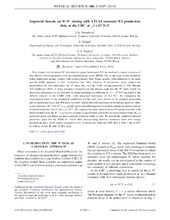Improved bounds on W−W′ mixing with ATLAS resonant WZ production data at the LHC at √s=13 TeV
Peer reviewed, Journal article
Published version

Åpne
Permanent lenke
https://hdl.handle.net/1956/23320Utgivelsesdato
2019Metadata
Vis full innførselSamlinger
Originalversjon
https://doi.org/10.1103/physrevd.100.015007Sammendrag
New charged vector bosons W ′ decaying into gauge boson pairs W Z are predicted in many scenarios of new physics, including models with an extended gauge sector (EGM). Due to the large variety of models (other unification groups, models with supersymmetry, little Higgs models, extra dimensions) the more general EGM approach is here considered. For what concerns W ′ -production, these models are parametrized by two parameters, the W ′ mass M W ′ and the W − W ′ mixing parameter ξ . The diboson W Z production allows to place stringent constraints on this mixing angle and the W ′ mass, which we determine and present for the first time by using data from p p collisions at √ s = 13 TeV recorded by the ATLAS detector at the CERN LHC, with integrated luminosity of 36.1 fb − 1 . By comparing the experimental limits to the theoretical predictions for the total cross section of W ′ resonant production and its subsequent decay into W Z pairs, we show that the derived constraints on the mixing angle are rather severe, between 10 − 4 and 10 − 3 , i.e., greatly improved with respect to those derived from the global analysis of electroweak data which yield ξ ≲ 10 − 2 . We combine the limits derived from W Z production data with those obtained from the W ′ → e ν process in order to significantly extend the exclusion region in the M W ′ − ξ parameter plane and obtain the most stringent exclusion limits to date. We present the combined allowed parameter space for the EGM W ′ boson after incorporating indirect constraints from low energy electroweak data, direct search constraints from Tevatron and from the LHC Run I with 7 and 8 TeV as well as at Run II with 13 TeV data.
